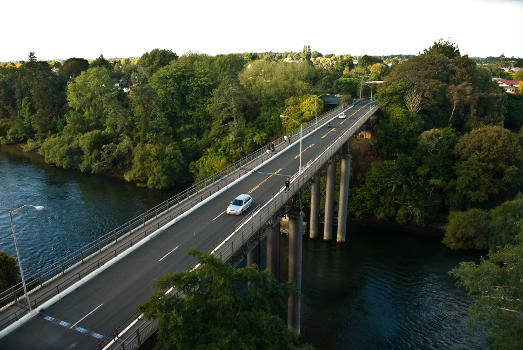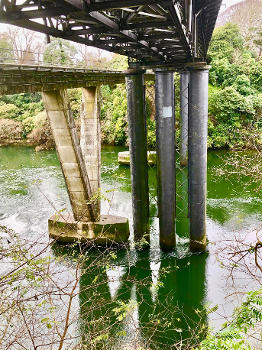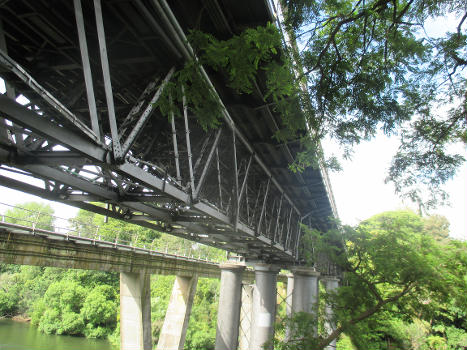General Information
Project Type
| Structure: |
Deck truss bridge |
|---|---|
| Material: |
Steel bridge |
| Plan view: |
Structurae Plus/Pro - Subscribe Now! |
| Structure: |
Warren type truss bridge Parallel-chord truss bridge |
| Material: |
Structurae Plus/Pro - Subscribe Now! |
| Function / usage: |
original use: Railroad (railway) bridge current use: Road bridge |
Awards and Distinctions
| 1985 |
for registered users |
|---|
Location
| Location: |
Hamilton, Waikato, New Zealand |
|---|---|
| Crosses: |
|
| Replaced by: |
Claudelands Railway Bridge (1964)
|
| Coordinates: | 37° 47' 4.06" S 175° 16' 58.98" E |
Technical Information
Dimensions
| main span | 40.23 m | |
| total length | 132.89 m | |
| number of spans | 3 | |
| height above valley floor or water | 31.39 m | |
| number of lanes | 2 | |
| track gauge | 1 067 mm | |
| abutments | number | 2 |
| piers | number | 2 x 3 |
Materials
| piers |
steel
|
|---|---|
| truss |
steel
|
Excerpt from Wikipedia
Claudelands Bridge is a dual-lane truss road bridge over the Waikato River, joining Claudelands with Hamilton Central. In 1968 it was converted from the old railway bridge, which had been completed about the end of July 1883. The road bridge was given a Category 2 listing in 1985.
Vehicle use has declined in recent years, but it is the second busiest CBD route for cyclists, with 135 in peak hours in 2009 and a rising trend. To make the bridge safer for the 600 cyclists a day, sharrows were added to the lane markings in 2019. Buses to Rototuna and route 11 cross the bridge.
A new railway bridge, opened on 19 September 1964, a few metres downstream, replaced the old with a 7-span, 143 m (469 ft) pre-stressed concrete box girder bridge.
Old railway bridge history
The bridge was designed in 1880 and the £5,519 contract let on 3 November 1881 to W. Sims. Although Sir George Grey turned the first sod of the railway extension at Claudelands in 1879, there seems to have been little publicity for that or the bridge, with only minimal mention in 1883. Ironwork for the bridge was reported as shipped in 1881.
Progress was very slow, so the contract was re-let to J. R. Stone on 18 September 1882 for £4,312 13s 6d, plus the £1,376 cost (the £5,688 total would now be equivalent to just under $1m) of the four cast cylinders from A & G Price. However, work stopped in November 1882, when it was realised the foundations were inadequate, requiring bracing of the cylinders and deepening of the foundations from 3 to 24 ft (7.3 m). The bridge was completed on 21 September 1883 and used for construction trains, until the Hamilton-Morrinsville railway opened on 1 October 1884.
It was originally tested with a 117-ton load. To cope with greater loads, an extra cylinder was added to the original two on each side of the main channel, the 2 new cylinders being ordered from S Luke & Co for £2,354 in 1906, and the new deck from A & T Burt Ltd for £5,872 in 1907. Further strengthening was designed in 1934 to cope with the 135-ton K-Class locomotives.
A commission was appointed to investigate in 1906. With the widening and strengthening of the bridge, it was possible to build a footbridge in 1908, though there were complaints about the lack of lighting and cycling was banned. The footbridge was renewed in 1936.
There was soon also pressure to remove the railway from the centre of the CBD. In 1912 the Borough Council suggested the line could be lowered. A 1938 plan was stopped by war in 1939. The National Roads Board then promoted it and, in September 1959, the Ministry of Works started the scheme to put the railway in a tunnel and replace the old bridge with one at the tunnel level.
Text imported from Wikipedia article "Claudelands Bridge" and modified on November 29, 2024 according to the CC-BY-SA 4.0 International license.
Participants
Currently there is no information available about persons or companies having participated in this project.
Relevant Web Sites
- About this
data sheet - Structure-ID
20089822 - Published on:
28/11/2024 - Last updated on:
28/11/2024







